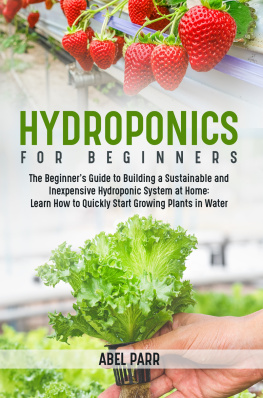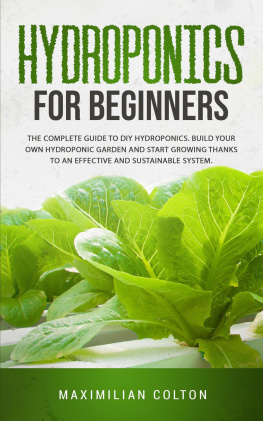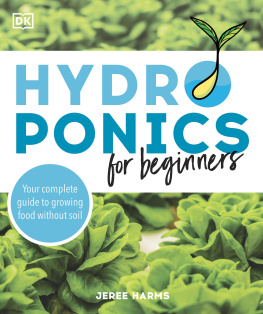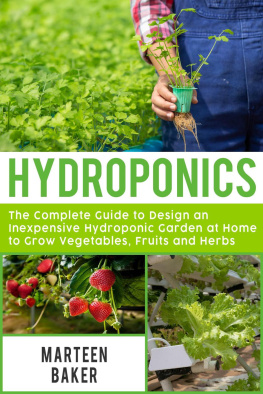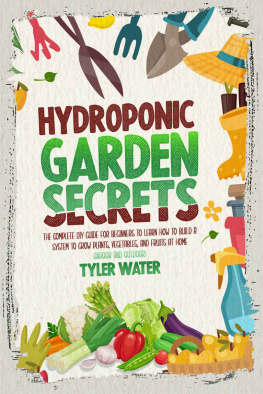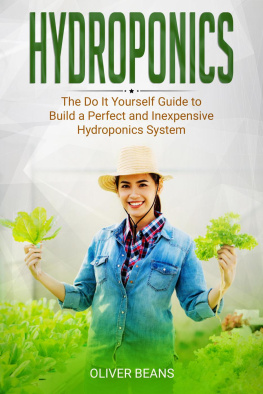Hydroponics For Beginners
The Beginner's Guide to Building a Sustainable and Inexpensive Hydroponic System at Home: Learn How to Quickly Start Growing Plants in Water
Abel Parr
Copyright All rights reserved.
This Book is provided with the sole purpose of providing relevant information on a specific topic for which every reasonable effort has been made to ensure that it is both accurate and reasonable. Nevertheless, by purchasing this eBook, you consent to the fact that the author, as well as the publisher, are in no way experts on the topics contained herein, regardless of any claims as such that may be made within. As such, any suggestions or recommendations that are made within are done so purely for entertainment value. It is recommended that you always consult a professional prior to undertaking any of the advice or techniques discussed within.
This is a legally binding declaration that is considered both valid and fair by both the Committee of Publishers Association and the American Bar Association and should be considered as legally binding within the United States.
The reproduction, transmission, and duplication of any of the content found herein, including any specific or extended information, will be done as an illegal act regardless of the end form the information ultimately takes. This includes copied versions of the work, both physical, digital, and audio unless express consent of the Publisher is provided beforehand. Any additional rights reserved.
Furthermore, the information that can be found within the pages described forthwith shall be considered both accurate and truthful when it comes to the recounting of facts. As such, any use, correct or incorrect, of the provided information will render the Publisher free of responsibility as to the actions taken outside of their direct purview. Regardless, there are zero scenarios where the original author or the Publisher can be deemed liable in any fashion for any damages or hardships that may result from any of the information discussed herein.
Additionally, the information in the following pages is intended only for informational purposes and should thus be thought of as universal. As befitting its nature, it is presented without assurance regarding its prolonged validity or interim quality. Trademarks that are mentioned are done without written consent and can in no way be considered an endorsement from the trademark holder.
INTRODUCTION
Hydroponics is on the rise, putting its global valuation at about $21.4 billion in 2015. Great global developments are on the horizon which is expected to intensify the development of this form of farming.
Out of necessity these reforms will be made to meet a rapidly expanding global population. We are already using a large proportion of the land available to produce crops, and new farming methods need to be created to increase yields or make other land viable for crop production. Vertical urban farming is a prospective farming approach that solves the problem of inadequate land, and works with hydroponics really well.

Hydroponics is the process of growing soil-less plants by delivering a steady solution of nutrients to them. Although this approach remains fairly unfamiliar outside of a small sector of the horticultural community, it has been around for a long time in fact. It is a device that has been commonly used in Babylon's hanging gardens, and has been extensively studied for the past few hundred years by scientists and horticulturalists.
There are many important explanations for commercial food producers to use this approach but the domestic gardener able to produce a high yield in a limited amount of space is also using it more often today. Although this is used mainly as a way to produce crops for the table, it is also a tool that can be used for ornamental plant growth.
All plants require nutrients from soil, light and dissolved to expand. Hydroponics allows for the delivery of a very specifically regulated quantity of nutrients, dissolved in water, directly to the root system as needed by the plant. Because the root system is no longer required to stretch so far to obtain the nutrients, this in turn allows the grower to plant his crops at much higher densities, and that's just another reason why hydroponic crop yields are that much higher than typical soil yields.
There are a variety of variants on the hydroponic theme, and there are plenty of options available to gardeners. Although some of the approaches may seem too complex for the home gardener, I urge you to continue because in many situations what may seem to be a difficult scheme to replicate at first is in fact surprisingly easy and the rise in yields will be astounding.
CHAPTER 1
About hydroponics
Primitive forms of hydroponics have been practiced for thousands of years by different societies. The term hy droponic itself derives from a fusion of two words from Ancient Greek, hydro for water and ponic for job. In other words, when he started to pursue agriculture, the water was meant to do the job that had produced such toil for mankind.
Different forms of it have been carried on in Cashmere for centuries, and one group, the American Aztecs, has developed a form of floating garden. Pushed by other more hostile groups into the marshy areas of Lake Tenochtitlan in what is now Mexico, these nomadic people were forced to come up with a viable agricultural system to survive. They created a network of floating rafts woven together from reeds that gradually transformed in to a floating island archipelago. Such islands were teeming with herbs, flowers and even fruit. The historian William Prescott recorded the colonizing Spaniards ' conquest of the Aztec empire and identified the floating gardens as' Wondering islands of Verdure, teeming with flowers and vegetables and rolling on the water like rafts.' Some historians believe that hydroponics was an important ingredient in the development of Babylon's famed hanging gardens, which was one of the seventeen. If that is the case, then this is potentially the first example of the hydroponics used as a form of farming.
The first scientific studies took place in more modern times in the 1600s, when the Belgian Jan van Helmont demonstrated that you could cultivate a willow in a tube containing 200 pounds of dry soil and feeding only with rain water. The willow shoot had achieved a weight of 160 pounds after five years while the soil had only shrunk by two ounces in weight. He concluded that plants are getting what they need from water for production. Although partially correct in his observations, the need for carbon dioxide and oxygen, which are also critical for plant growth, was not taken into account by early demonstration.
John Woodwards took the method a further stage in 1699 when he produced plants in water containing differing amounts of contaminated soil. The plants which had the highest soil concentrations grew fastest. In this early version of the man-made hydroponic solution Woodwards realized that soil probably contained some nutrient crucial to plant growth but he was unable to identify what those nutrients were with chemistry yet to be discovered.
In the decades that followed, research began to gather momentum and scientists were able to prove that plants consumed water from their roots, and that this then progressed into their structures to be released by pores in the leaves. We also noticed the roots extracting nitrogen and oxygen and leaves taking carbon dioxide from the soil as well.
In 1851, French chemist Jean Baptist Boussingault began experimenting with inert rising media and water with different combinations of soil-based materials. In 1860 Professor Julius von Sachs released the first nutrient solution in which plants can be grown. Different solutions continued to be developed but all experiments had been focused on laboratory work at this point. It was not until the 1920's that Doctor William Gericke started to expand lab work to include agricultural crop production. He justified the use of the term hydroponics in the process and laid the groundwork as we know it for all forms of modern hydroponics. Developments have persisted, of course, and this is still an emerging science today, but we now have a much better handle on growing plant methods without using soil.
Next page
